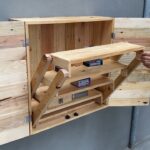I. Understanding the Value of Upcycled Clothing
II. Factors to Consider When Pricing Upcycled Fashion
III. Strategies for Setting Competitive Prices in the Upcycled Market
Understanding the Value of Upcycled Clothing
Have you ever thought about where your clothes come from? In recent years, the fashion industry has seen a delightful shift towards sustainability, and upcycled clothing has taken center stage. But what exactly is upcycled clothing, and why should we care about it? Let’s dive into the vibrant world of upcycling and uncover its true value.
What is Upcycled Clothing?
At its core, upcycling is the creative reuse of materials or products to generate new, higher-quality items. In the context of clothing, this means taking old garments or textiles and transforming them into something fresh and fashionable. Think of it as giving a second chance to items that might otherwise end up in a landfill.
Environmental Impact
One of the most significant values of upcycled clothing lies in its positive environmental impact. The fashion industry is notorious for its wastefulness—producing heaps of textiles that are often discarded. According to the Environmental Protection Agency, approximately 11.3 million tons of textile waste are generated each year in the U.S. alone!
By choosing upcycled clothing, you are:
- Reducing Waste: Each upcycled piece saves textiles from the landfill.
- Conserving Resources: Upcycling requires less energy and water than making new clothes from scratch.
- Decreasing Carbon Footprint: By extending the lifecycle of materials, upcycling minimizes the demand for new production, which can be resource-intensive.
Creativity and Uniqueness
Another fantastic aspect of upcycled clothing is the creativity involved in the process. Designers and artisans often pour their heart and soul into each piece, resulting in garments that are truly one-of-a-kind. When you wear upcycled fashion, you embrace individuality, leaving behind the cookie-cutter styles found in fast fashion.
Imagine strutting your stuff in a dress that tells a story—maybe it was an old pair of jeans transformed into a chic skirt or a vintage tablecloth turned into a fashionable top. Not only are you wearing something unique, but you’re also supporting the skills and creativity of upcyclers who breathe new life into forgotten materials.
Supporting Local Economies
Upcycled clothing often comes from small businesses or independent creators who prioritize sustainable practices. By choosing to purchase upcycled fashion, you’re not just getting a stylish piece; you’re also supporting local economies and promoting ethical production methods. It’s a win-win!
Building Awareness and Community
When you embrace upcycled clothing, you’re also joining a broader movement towards sustainability and conscious consumerism. This shift cultivates awareness about the impact of our fashion choices and fosters a sense of community among those who value the planet. Sharing your upcycled finds on social media or at local markets can inspire others to think critically about their fashion habits, too!
In summary, upcycled clothing is more than just a trend; it’s a transformative approach to fashion that values creativity, sustainability, and community. By understanding its significance, you can make more conscious choices in your wardrobe and contribute to a brighter, greener future. So, why not explore the wonderful world of upcycled fashion? You might just find a gem that speaks to you!
Factors to Consider When Pricing Upcycled Fashion
When it comes to pricing upcycled clothing, there’s a lot more to think about than just the fabric and stitching. Upcycling is an art form that involves creativity, sustainability, and a keen eye for design. So, how do you determine what your unique pieces are worth? Let’s dive into some key factors to consider when pricing your upcycled fashion items.
1. Material Costs
The first thing to consider is the cost of the materials used in your creations. Even though upcycled fashion often utilizes pre-loved fabrics, there are still costs associated with:
- Purchasing additional materials (like zippers, buttons, or linings)
- Cleaning or repairing old garments
- Tools or supplies for alterations
Make sure to calculate the total expense of materials to ensure you’re at least covering your costs!
2. Time and Labor
Your time is valuable! It’s crucial to factor in the hours spent designing, sewing, and perfecting each piece. When setting your price, consider:
- How many hours it took to create the piece
- Your skill level and expertise (if you’re a seasoned designer, your time is worth more!)
- The complexity of the design or construction
Remember, upcycled fashion is a labor of love, and the time you invest deserves to be compensated!
3. Unique Selling Proposition (USP)
What makes your upcycled clothing stand out? Is it the one-of-a-kind design? The story behind each piece? Your USP adds value to your items, so consider how it influences pricing:
- Are you using rare fabrics or vintage finds that are hard to come by?
- Do your pieces have a unique design that sets them apart from mass-produced clothing?
- Are you promoting ethical and sustainable fashion practices that resonate with your target audience?
Highlighting these unique aspects can justify a higher price point.
4. Market Trends
It’s essential to keep an eye on the market trends in the upcycled and sustainable fashion scene. Here are some tips to help you gauge the right price:
- Research what similar brands or designers are charging for comparable items.
- Attend craft fairs or pop-up shops to see how your pieces stack up against others.
- Stay updated on consumer preferences—what are shoppers currently interested in?
Being aware of market trends can help you find the sweet spot for your pricing!
5. Target Audience
Finally, consider who your target audience is. Understanding their spending habits and preferences will guide your pricing strategy:
- Are your customers looking for affordable, everyday wear?
- Or are they willing to invest in something unique and sustainable?
- How much value do they place on ethical fashion?
Your audience’s willingness to pay will heavily influence your pricing decisions.
By considering these factors—material costs, time and labor, your unique selling proposition, market trends, and your target audience—you’ll be well on your way to pricing your upcycled clothing effectively. Happy creating and pricing!
Strategies for Setting Competitive Prices in the Upcycled Market
So, you’ve decided to dive into the fabulous world of upcycled fashion. That’s awesome! But let’s talk about one of the trickiest parts of this journey: pricing your creations. Setting the right price can be a balancing act, but don’t worry, I’ve got some friendly strategies to help you out!
1. Know Your Costs
Before you can confidently set a price, you need to understand what it costs you to create each piece. This isn’t just about the materials; consider:
- Materials: What did you spend on fabrics, buttons, and other essentials?
- Labor: How much time did you invest? It’s important to value your work!
- Overhead: Any extra expenses, like rent for your workspace or tools, should be factored in.
Once you have a clear picture of your costs, you can move on to setting a price that reflects the value you provide.
2. Research the Market
Get a feel for what other upcycled fashion creators are charging. Look at similar items on platforms like Etsy, local markets, or social media. Ask yourself:
- What are the price ranges for similar items?
- What unique features do your pieces have that could justify a higher price?
- Are there trends in pricing based on season or style?
This research will help you identify where your creations fit within the market landscape.
3. Highlight Your Unique Selling Proposition (USP)
Your creations are unique, and that’s a big selling point! Make sure to highlight what makes your upcycled clothing special. Is it the story behind the piece? The craftsmanship involved? The eco-friendly aspect? Whatever it is, make it known! Here’s how to do it:
- Storytelling: Share the journey of the materials and how they were transformed into fashion.
- Quality: Emphasize the skill and care you put into each piece.
- Eco-Consciousness: Highlight the sustainability of your practices to appeal to eco-minded consumers.
When customers connect with your story and values, they’re often more willing to pay a premium.
4. Implement Psychological Pricing
Sometimes, a little psychology can go a long way in pricing. Consider using pricing strategies like:
- $49.99 instead of $50: This tiny change can make a big difference in perceived value!
- Bundles: Offer discounts for purchasing multiple items, encouraging larger sales.
- Limited Editions: Create a sense of urgency by pricing items slightly higher if they’re exclusive.
These tactics can help you attract more buyers without compromising on your value.
5. Be Open to Feedback
Finally, never underestimate the power of feedback! Engage with your customers and ask how they feel about your pricing. This can provide invaluable insights into whether you need to adjust your prices or if you’re spot on.
Remember, pricing is not a one-time task; it’s an evolving process. Keep experimenting, stay connected to your community, and enjoy the journey of creating and selling your upcycled fashion!










Comments